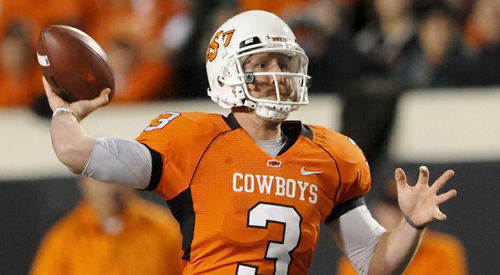
Oklahoma State, the little program that could… buy success?
Oklahoma State University football was, upon a time, nothing much to speak of. The doldrums that enveloped the team during the 1990s lowered the national stature of a program that saw Heisman Trophy winner and NFL Hall of Fame member Barry Sanders lift it to some of the program’s greatest heights. Unfortunately, like Southern Methodist University before it, OSU fell victim to sanctions imposed due to a scandal involving a so-called bidding war for recruits, and only after Les Miles and alumnus Mike Gundy were brought in did the program achieve more success.
After Miles’ resignation to lead LSU in late 2004, Gundy took control of the program. For quite a while it seemed he would be best known for his famous outburst during a press conference, and that OSU would be overshadowed by the 800-pound gorilla some 80 miles away in Norman. Now, though, the program sits in third place in the BCS standings, ahead of erstwhile powerhouses Oklahoma and Texas. The offense, behind the NCAA’s second-ranked passing game, has lit up the scoreboard to the tune of 70 points against Kansas, 38 against Texas and 45 against Missouri last week.
However, despite their 7-0 record, not everything’s positive for the Cowboys. They’ve score 48.6 points per game but still have some major question marks on defense, where they’ve allow 26.7 points per game. Some of this could be attributed to the danger (and the increase in the number of plays per game) that comes with a pass-happy offense, while another line of thinking holds that a team that can obliterate most opponents on offense would only allow garbage touchdowns (the Kansas game was an example of this), but the defense is still a long way from most championship-caliber units.
The Cowboys’ signature win of the season so far was a 30-29 comeback victory at then-No. 8 Texas A&M. Most encouraging was the fact that A&M was held to a second-half touchdown and an elective safety by OSU to seal the game. If OSU can sort out its defense soon, it looks to have a viable chance of earning a bid to the BCS. The program has its best chance in years of really making an impact on the national scene. This should be a feel-good story, a program that has paid its dues and built the right way with only the help of a lowly megabooster to spur them on.
[php snippet=1]
But wait, who is this megabooster? None other than legendary oilman and corporate raider T. Boone Pickens. Pickens is Oklahoma State’s most famous alumnus by a wide margin, and his name is a byword for the Texas oilman of old (though Pickens was born in Oklahoma). This isn’t to suggest that Pickens is some sort of Daddy Warbucks of the oil business. Far from it, actually. Pickens has championed alternative energy and contributed to a variety of charitable causes. However, chief amongst those causes is Oklahoma State.
Pickens has given nearly $500 million to OSU (though some of this is managed by his own companies and fluctuates with the markets). The stadium in Stillwater carries his name. At this point, the entire athletic department might as well carry his name. There’s no evidence that OSU is engaging in illegal recruiting tactics using Pickens’ money, but the facilities Pickens has provided (including a sparkling new basketball facility) and his continued financial support of OSU make it a very attractive place for recruits to play. Pickens effectively invested in OSU, and now we’re seeing his generosity bear fruit.
For a program that lacks the tradition of Alabama, the star power of USC, the academics of Stanford, the 100,000-person stadium of Ohio State and one that gets second billing in its home state, OSU is remarkably successful. For better or worse, success would likely have been impossible without T. Boone Pickens’ money.
The fact that money can level the playing field in college football is indisputable. SMU’s famous pay-for-play scandal in the mid-1980s is perhaps the best example of that influence being taken to the extreme. While OSU does not have the same large pool of affluent alumni as SMU, Michigan or Texas, Pickens’ involvement levels the playing field in the intense competition for recruits and nationally televised games.
That fact, of course, begs the question of whether or not anyone will notice or care that it seems as though there is a strong correlation between money and success in college football. This is not surprising.
Considering that the NCAA still perpetuates the farce that is the depiction of the modern Division I football player as a scholar-athlete instead of an athlete-scholar, universities naturally turned to something to give them advantage over their peers. It’s only difficult to see many other universities having a situation like OSU’s because of the rarity of people like T. Boone Pickens (although Oregon and Nike head honcho Phil Knight appear to be carved from a similar mold). If every university could have a megabooster that also emblemized the university’s athletic program, it is not a great leap to assume that they would seize the opportunity.
At the same time, there is nothing to suggest that the NCAA will attempt to eliminate the role of boosters in Pickens’ vein. The right of the individual to do whatever he or she wishes with his or her money is a difficult one to restrict, and Pickens’ contributions to OSU appear to have been entirely aboveboard. That makes for a remarkable contrast with other, more dubious boosters, like Miami’s Nevin Shapiro.
The only tool the NCAA has to diminish the role of legal megaboosters in a program’s success is a program to compensate student-athletes, and that appears unlikely to happen. Thus, it’s not impossible for programs like Oklahoma State to go from rags to riches; they just need the right backer providing the riches.
[php snippet=1]

